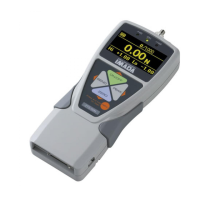
Do you have a question about the Imada ZTS Series and is the answer not in the manual?
| Display | LCD |
|---|---|
| Sampling Rate | 2000 Hz |
| Measurement Units | N, kgf, lbf |
| Data Output | USB, RS-232 |
| Power Supply | AC adapter or battery |
| Battery Life | Approx. 8 hours |
| Operating Temperature | 0°C to 40°C |
| Storage Temperature | -10°C to 50°C (14°F to 122°F) |
| Accuracy | +/- 0.2% F.S. |
Details standard features like selectable modes, units, setpoints, and memory.
Covers essential safety measures to prevent injury and equipment damage.
Explains the three-section display and how to navigate it.
Describes the single display mode, keypad functions, and LED indicators.
Steps for connecting remote sensors to the ZTS display unit.
Instructions for charging the rechargeable battery pack.
Guide to configure the gauge's internal date and time settings.
How to choose between lbf, N, and kgf units.
Inverting the screen orientation for specific mounting applications.
Setting high and low limits for Go/No Go testing with LED indicators.
Prevents unintended changes to gauge settings by locking them.
Attaching accessories and selecting between Real Time and Peak modes.
How to zero the display and tare attachments.
Accessing data previously saved in the gauge's memory.
Procedures for deleting data from the gauge memory.
Downloading data via USB and RS-232C connections.
Transferring data using analog signals or Mitutoyo Digimatic.
Using external signals for gauge functions like power, zero, and send.
Overview of software for data capture, analysis, and graphing.
Details pin assignments for output signals like -NG, OK, +NG, OVL, READY.
Pin assignments for inputs and serial/Digimatic data communication.
Defines the format for data output, including type, force, and setpoints.
Table listing codes for various force units like N, kgf, lbf.
Commands for data requests and configuring setpoints.
Commands to switch modes, units, and perform resets.
Commands for memory management, power control, and other functions.
Compatibility commands for data output and memory operations.
Compatibility commands for unit, mode, and setpoint configuration.
Step-by-step guide to install the USB driver for ZT Logger.
Verifying successful driver installation via Device Manager.
Steps to enable unsigned driver installation on Windows 8.
Instructions for installing the ZTS driver on Windows XP.
Requirement for ZT Logger; installation guide.
Procedures for installing the ZT Logger application.
Introduction to the ZT Logger main window and menus.
Using the Zero, Peak, and Zero Both buttons in ZT Logger.
Capturing data, viewing the data table, and statistics.
Managing continuous data capture and monitoring connection status.
Configuring data display items and resetting zero values.
Detailed steps for capturing single data points or continuous streams.
Importing data from the force gauge's memory into ZT Logger.
Configuring trigger conditions for automatic data acquisition.
Procedures for deleting data from the ZT Logger table and gauge memory.
Options for saving new files or appending to existing CSV files.
Transferring data to clipboard for pasting into other applications.
Adjusting gauge settings like setpoints and outputs through ZT Logger.
Managing gauge configuration profiles by saving and loading them.
Key performance specs including accuracy, overload, and outputs.
Table detailing the capacity and resolution for different ZTS models.
Technical drawings showing dimensions for standard ZTS gauges.
Technical drawings showing dimensions for high-capacity ZTS gauges.
Explains the three-section display and navigating the upper section.
How to navigate and select data within the lower display section.
Accessing memory data and high/low setpoints in Multi Display.
Steps to switch to and configure the Single Display mode.
Detailed steps to set high/low limits and their associated LED indicators.
Explains 'Or Peak' and 'And Peak' capture modes.
Setting up the gauge to automatically store peak values.
Methods for recalling and clearing stored data from memory.
Configuring the timer for automatic zeroing of the display.
Adjusting keypad beep and high/low alarm sound settings.
Choosing between Multi and Single display modes.
Setting the display brightness for optimal visibility.
Inverting the screen for use on test stands.
Setting the time before the gauge automatically powers off.
Step-by-step guide to set the gauge's date.
Step-by-step guide to set the gauge's time.
Choosing the desired units for force measurement.
Setting the display for compression (+) and tension (-).
Selecting sensitivity for optimal measurement accuracy.
Configuring how the Zero/Tare reset function behaves.
Determining which values are sent when the SEND button is pressed.
Choosing the display format for dates.
Changing the language displayed on the gauge.
Enabling the lock to prevent accidental setting changes.
Details on warranty periods, covered products, and exclusions.
Instructions for warranty claims and customer support contact details.